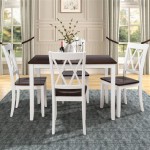Solid Wood Antique Dining Table: A Timeless Investment
The allure of antique furniture lies in its inherent charm, historical significance, and enduring quality. Among the various pieces that capture this essence, the solid wood antique dining table holds a particularly prominent position. These tables are not merely functional items; they are tangible links to the past, reflecting craftsmanship, design aesthetics, and social customs of bygone eras. Their value extends beyond their utility, making them both practical additions to a home and potentially appreciating investments.
Solid wood construction is a defining characteristic of genuine antique dining tables. This distinguishes them from modern counterparts often manufactured with veneers, particleboard, or other composite materials. Understanding the types of wood used, the construction techniques employed, and the historical context of these tables is crucial for appreciating their value and ensuring their proper care.
Identifying Solid Wood and Evaluating Construction
Determining whether a dining table is constructed from solid wood requires careful observation. Look for consistent grain patterns across all surfaces, including the tabletop, legs, and aprons. Solid wood will exhibit a continuous grain, while veneered surfaces will show a thin layer of wood adhered to a substrate. Edges are particularly telling; carefully examine them for any evidence of layering or a different material underneath the surface veneer.
The type of wood used is also a significant factor. Common woods for antique dining tables include oak, mahogany, walnut, cherry, and pine. Each wood possesses distinct characteristics regarding grain, color, and density. Oak, known for its strength and durability, was frequently used in earlier periods, particularly for larger, more robust tables. Mahogany, prized for its rich color and fine grain, became popular in the 18th and 19th centuries, gracing more formal dining rooms. Walnut offered a versatile option, lending itself to both elaborate carvings and simpler, more utilitarian designs. Cherry, with its warm reddish-brown hue, was favored for its smooth texture and ability to take a fine polish. Pine, while often considered a softer wood, was commonly used for more rustic or country-style tables.
Construction methods provide further clues about the age and authenticity of an antique dining table. Dovetail joints, mortise-and-tenon joints, and hand-carved details are hallmarks of older, expertly crafted pieces. Machine-made joinery and mass-produced components are indicative of later periods or reproductions. The presence of original hardware, such as hinges, locks, and drawer pulls, can also add to the table's value and provide insights into its history. Look for signs of wear and tear, such as scratches, dents, and repairs, which can contribute to the table's character and authenticity.
Examining the underside of the table is essential. This area often reveals details about the table's construction and any subsequent modifications. Look for evidence of original glue blocks, corner braces, and any markings or labels that might indicate the manufacturer or origin of the table. Dust and dirt accumulation can also offer clues about the table's age and how it has been stored.
Understanding Historical Styles and Periods
Antique dining tables reflect the design trends and social customs of their respective eras. Recognizing the characteristics of different historical styles is essential for accurately identifying and appreciating an antique table. Some prominent styles include:
Queen Anne (early 18th century): Characterized by graceful curves, cabriole legs, and understated ornamentation. Queen Anne tables often feature drop-leaf designs, allowing them to be expanded for larger gatherings. Walnut was a common wood used during this period.
Chippendale (mid-18th century): Known for its elaborate carvings, claw-and-ball feet, and a variety of leg styles, including straight, cabriole, and Marlborough. Chippendale tables often showcase intricate fretwork and pierced splats. Mahogany was a popular choice for Chippendale furniture.
Hepplewhite (late 18th century): Marked by its elegant simplicity, slender legs, and oval or shield-shaped backs. Hepplewhite tables often feature delicate inlays and painted decorations. Mahogany and satinwood were frequently used in Hepplewhite designs.
Sheraton (late 18th and early 19th century): Characterized by its neoclassical influence, straight lines, and reeded legs. Sheraton tables often incorporate decorative elements such as swags, ribbons, and urns. Mahogany, satinwood, and rosewood were common materials.
Empire (early 19th century): Featuring bold, architectural forms, heavy proportions, and classical motifs such as columns, scrolls, and eagles. Empire tables were typically made of mahogany and often adorned with ormolu (gilt bronze) mounts.
Victorian (mid-19th century): Encompassing a wide range of styles, from Gothic Revival to Renaissance Revival to Rococo Revival. Victorian tables often showcase elaborate carvings, ornate details, and a variety of woods, including mahogany, walnut, and rosewood.
Identifying the historical style of a dining table can help determine its approximate age and provenance. It also provides insights into the design trends and cultural influences that shaped its creation. Consulting reference books, museum collections, and antique experts can be valuable resources for identifying and researching antique dining tables.
Assessing Condition and Value
The condition of an antique dining table is a significant factor in determining its value. Generally, tables in original condition with minimal wear and tear command higher prices. However, some degree of wear is expected in antique furniture and can even contribute to its character. Major damage, such as broken legs, missing pieces, or extensive water damage, can significantly reduce the table's value.
Before purchasing an antique dining table, carefully inspect it for any signs of damage or repairs. Look for cracks, splits, warps, and insect infestations. Check the stability of the legs and ensure that the tabletop is level. Examine the finish for any signs of flaking, chipping, or fading. Note any repairs that have been made and assess the quality of the workmanship. A well-executed repair can be acceptable, but poorly done repairs can detract from the table's value.
The market value of an antique dining table is influenced by several factors, including its age, rarity, condition, style, and provenance. Tables from earlier periods, rarer designs, and those with documented histories tend to be more valuable. The desirability of a particular style can also fluctuate over time, affecting its market value. Consulting with antique appraisers, researching recent auction results, and comparing prices of similar tables offered for sale can help determine a fair market value.
Restoration and conservation are important considerations for preserving antique dining tables. Cleaning, polishing, and waxing can help protect the finish and enhance the table's appearance. However, avoid using harsh chemicals or abrasive cleaners, as these can damage the original finish. Major repairs, such as replacing missing pieces or refinishing the tabletop, should be undertaken by experienced professionals who specialize in antique furniture restoration.
Maintaining the proper environment is also crucial for preserving antique dining tables. Avoid placing tables in direct sunlight or near sources of heat or humidity, as these can cause the wood to dry out, warp, or crack. Regularly dusting and cleaning the table can help prevent the accumulation of dirt and grime. Consider using a tablecloth or protective pad to prevent scratches and spills. With proper care and maintenance, an antique dining table can remain a beautiful and valuable heirloom for generations to come.
Owning a solid wood antique dining table is more than just acquiring a piece of furniture; it's investing in a piece of history. These tables offer a tangible connection to the past, reflecting the craftsmanship, design aesthetics, and social customs of previous generations. By understanding the characteristics of solid wood construction, recognizing historical styles, and assessing condition and value, individuals can make informed decisions when purchasing and caring for these timeless treasures.
The patina, the accumulated wear and subtle changes of color that develop over decades or centuries, is itself a testament to the table's age and use. A carefully preserved patina can add to the table's charm and value, further distinguishing it from modern reproductions. This natural aging process is impossible to replicate authentically, making it a unique characteristic of genuine antique pieces.
Ultimately, the decision to acquire an antique dining table should be based on a combination of factors, including personal preferences, budgetary considerations, and the table's suitability for the intended space. However, by approaching the process with knowledge and discernment, it is possible to find a solid wood antique dining table that will become a cherished centerpiece for years to come, enriching the home with its history, beauty, and enduring value.

Free Shipping Trestle Table Bavarian Dining Barnwood Strong Oaks Wood

Sold Antique Petite Jacobean Dining Table Solid Wood Vintage Furniture Etsy

Flash Furniture Grace 60 Solid Wood Dining Table With Turned Wooden Legs Grade Heavy Duty Rectangle For 6 Walnut Matte Finish

Vintage Oak Base Distressed Dining Table

Vintage French Provencal Farm Table Desk Dining In Solid Cherry Wood

San Rafael Dining Table Antique Oak

550 Farm Table Harvest Kitchen Small Dining Farmhouse Inventiadesign Sustainable Solid Wood Antique Finish Etsy

Oak Trestle Table Antique Style Wooden Dining Mission Farmhouse Solid Kitchen Hand Crafted Hardwood

Antique French Solid Wood Round Pedestal Dining Table Chairish

Explore Our Range Of Fabulous Antique Dining Table And Chairs Sets Regent Antiques








